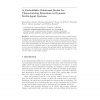71 search results - page 3 / 15 » A Semantic Foundation for Hidden State |
TOPLAS
2010
13 years 5 months ago
2010
Fractional permissions use fractions to distinguish write access (1) from read access (any smaller fraction). Nesting (an extension of adoption) can be used to model object invari...
SIGCSE
2009
ACM
14 years 8 months ago
2009
ACM
commonly stated definition of abstract data type (ADT) is that it is a domain of values and the operations over that domain. So, for example, a language's built-in types, lik...
GFKL
2007
Springer
14 years 1 months ago
2007
Springer
Abstract. Artificial systems with a high degree of autonomy require reliable semantic information about the context they operate in. State interpretation, however, is a difficult ...
SSPR
2004
Springer
14 years 24 days ago
2004
Springer
The creation of a cognitive perception systems capable of inferring higher-level semantic information from low-level feature and event information for a given type of multimedia co...
NIPS
2004
13 years 8 months ago
2004
Schema learning is a way to discover probabilistic, constructivist, predictive action models (schemas) from experience. It includes methods for finding and using hidden state to m...

